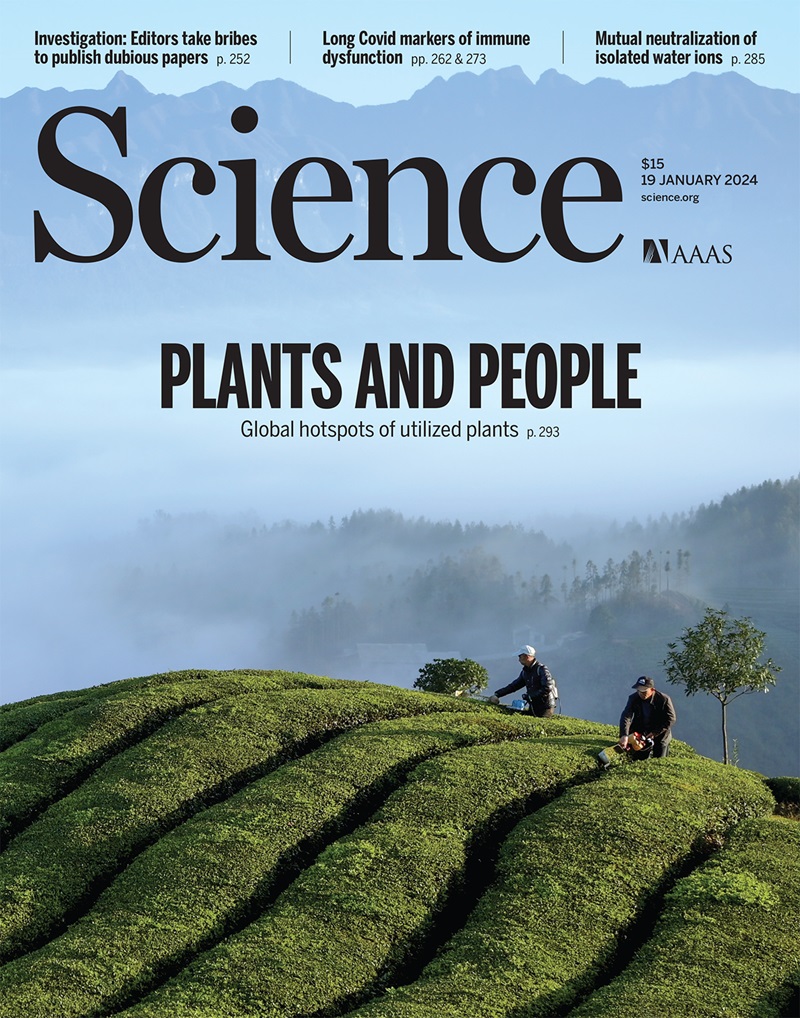一种典型蛋白复合物控制着免疫平衡和多种病原体的抵抗力
IF 44.7
1区 综合性期刊
Q1 MULTIDISCIPLINARY SCIENCES
引用次数: 0
摘要
Ca 2+ 传感器 ROD1 是水稻免疫的主调节器。通过筛选rod1突变体的抑制因子,我们发现ROD1通过监控典型免疫途径的激活来调节免疫稳态。OsTIR(TIR-only protein)、OsEDS1(Enhanced Disease Susceptibility 1)、OsPAD4(Phytoalexin Deficient 4)和OsADR1(Activated Disease Resistance 1)的突变都会削弱杆1植株的抗病性。OsTIR 催化产生第二信使 2′-(5′′-磷酸核糖基)-5′-腺苷单磷酸(pRib-AMP)和二磷酸(pRib-ADP),从而引发 OsEDS1-OsPAD4-OsADR1 (EPA)免疫复合物的形成。ROD1 与 OsTIR 相互作用并抑制其酶活性,而 ROD1 的突变会导致 EPA 复合物的持续激活。因此,我们揭示了一个免疫网络,它能微调水稻的免疫平衡和多病原抗性。本文章由计算机程序翻译,如有差异,请以英文原文为准。
A canonical protein complex controls immune homeostasis and multipathogen resistance
The Ca 2+ sensor, ROD1, is a master regulator of immunity in rice. By screening suppressors of rod1 mutants, we show that ROD1 governs immune homeostasis by surveilling the activation of a canonical immune pathway. Mutations in OsTIR ( TIR-only protein ), OsEDS1 ( Enhanced Disease Susceptibility 1 ), OsPAD4 ( Phytoalexin Deficient 4 ), and OsADR1 ( Activated Disease Resistance 1 ) all abolish enhanced disease resistance of rod1 plants. OsTIR catalyzes the production of second messengers 2′-(5′′-phosphoribosyl)-5′-adenosine monophosphate (pRib-AMP) and diphosphate (pRib-ADP), which trigger formation of an OsEDS1-OsPAD4-OsADR1 (EPA) immune complex. ROD1 interacts with OsTIR and inhibits its enzymatic activity while mutation of ROD1 leads to constitutive activation of the EPA complex. Thus, we unveil an immune network that fine-tunes immune homeostasis and multipathogen resistance in rice.
求助全文
通过发布文献求助,成功后即可免费获取论文全文。
去求助
来源期刊

Science
综合性期刊-综合性期刊
CiteScore
61.10
自引率
0.90%
发文量
0
审稿时长
2.1 months
期刊介绍:
Science is a leading outlet for scientific news, commentary, and cutting-edge research. Through its print and online incarnations, Science reaches an estimated worldwide readership of more than one million. Science’s authorship is global too, and its articles consistently rank among the world's most cited research.
Science serves as a forum for discussion of important issues related to the advancement of science by publishing material on which a consensus has been reached as well as including the presentation of minority or conflicting points of view. Accordingly, all articles published in Science—including editorials, news and comment, and book reviews—are signed and reflect the individual views of the authors and not official points of view adopted by AAAS or the institutions with which the authors are affiliated.
Science seeks to publish those papers that are most influential in their fields or across fields and that will significantly advance scientific understanding. Selected papers should present novel and broadly important data, syntheses, or concepts. They should merit recognition by the wider scientific community and general public provided by publication in Science, beyond that provided by specialty journals. Science welcomes submissions from all fields of science and from any source. The editors are committed to the prompt evaluation and publication of submitted papers while upholding high standards that support reproducibility of published research. Science is published weekly; selected papers are published online ahead of print.
 求助内容:
求助内容: 应助结果提醒方式:
应助结果提醒方式:


